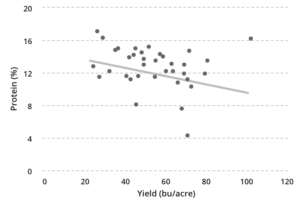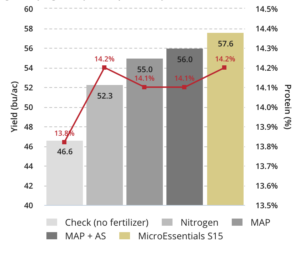SUMMARY
Compared to the Check (no fertilizer), the addition of N increased both yield and protein.
MAP provided a +2.7 bu/ac yield increase over N, but had a slight drop in protein.
The addition of S from AS added +1 bu/ac compared to MAP alone.
MicroEssentials S15 increased yield over MAP (+2.6 bu/ac) and MAP+AS (1.6 bu/ac).
The largest yield occurred with MicroEssentials S15 (57.6 bu/ac) while maintaining grain protein (14.2%); demonstrating the benefit of two forms of S in meeting spring wheat S demands in flowering/grain fill periods.
OVERVIEW
Spring wheat requires a balanced crop nutrition program that maximizes both yield and grain protein (%).
Proper fertility for maximum yield is needed season-long, but research shows that late season nitrogen (N) and sulfur (S) is especially important to maximize grain protein.
In addition to N, MAP or a MAP+AS blend is commonly applied at planting to meet phosphorus (P) and sulfur (S) requirements.
Growers are searching for fertilizer sources that can provide both early- and late-season crop nutrition needs; especially important in seasons that are not conducive to late-season fertilizer applications.
MicroEssentials S15 is a performance phosphate fertilizer that provides two forms of S (sulfate + elemental) for season-long S availability.
Research has shown that the addition of phosphate fertilizer will increase yield, but maintaining grain protein (%) is more difficult as yields increase. As an example, MAP treatments were selected from the 39 trials in this experiment and yield x protein data was used to demonstrate the “dilution” effect that occurs with higher yield. (See Figure 1)
TRIAL DETAILS
Crop: Spring Wheat (Triticum aestivum)
Years: 11 years (2004-10; 2015-18)
Trials: 39 site-years across the U.S. and Canada. United States: ID, MN, MT, ND, SD; Canada: AB and SK
Data Source: Field studies conducted by third party independent researchers.
Experimental Design: Small-plot RCBD with 4 replications.
Cropping Conditions: Nitrogen was balanced across all trials. Sulfur treatments were balanced across MAP + AS and MicroEssentials S15 across all trials. Phosphorus treatments were balanced across each trial at either 33 lbs P₂O₅/ac or 40 lbs P₂O₅/ac (Rates were slightly increased over the years.)
Application Details: Cropping systems followed local practices. Fertilizer was broadcast incorporated.
RESULTS
Figure 1: Relationship between yield and protein (%) for MAP Treatments. Each dot represents the trial mean (n=39)

Figure 2: Spring Wheat yield and protein % by treatment
